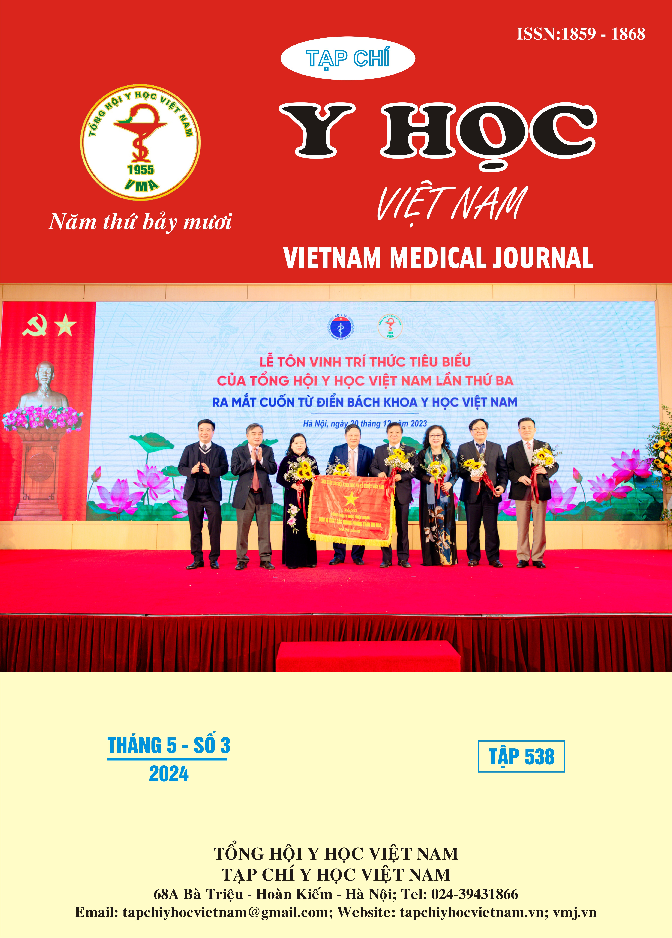RESULTS OF APPLYING 1-HOUR AND 3-HOUR SEPSIS TIME BUNDLES IN THE TREATMENT OF SEVERE SEPSIS, SEPTIC SHOCK AT THE EMERGENCY DEPARTMENT OF NGHE AN FRIENDSHIP GENERAL HOSPITAL
Main Article Content
Abstract
Objective: Evaluate the results of applying 1-hour and 3-hour sepsis time bundles in the treatment of severe sepsis, septic shock at the Emergency Department of Nghe An Friendship General Hospital. Subject and method: Cross-sectional description combined with retrospective and prospective data on evaluation of treatment application of 1-hour and 3-hour sepsis time bundles was performed on 152 patients diagnosed with severe infection and septic shock (according to Sepsis-3 definition qSOFA score ≥ 2). The study was conducted from April 2023 to October 2023. Results: the overall compliance rate with recommendations is 86.9%, compliance with fluid replacement accounts for the rate of 98.7%, compliance with blood lactate measurement is 100%, giving appropriate antibiotics in the first hour is 83.6%, compliance with blood culture is 88. 2. Treatment results: the rate of stable disease transferred to a lower level or healthy discharge from the hospital accounted for 66.5%, the rate of severe disease predicted death, the family asked to return home or died. in the Intensive Care Unit, accounting for 33.5%. There are 37.5% of patients on ventilators, the average stay in the Intensive Care Unit is 5.8 days, the least is 1 day and the longest is 24 days. Conclusion: Initial research results show that the application and monitoring of compliance to achieve the goals in the first 1-3 hours according to the recommendations of SSC 2018 for patients with sepsis and septic shock have achieved quite good results. However, studies with a larger number of patients are needed to more closely evaluate the impact on clinical outcomes.
Article Details
Keywords
severe infection, septic shock, 1-hour and 3-hour sepsis time bundles.
References
2. Lynn, N.B., et al., Severe sepsis 3-hour bundle compliance and mortality. Am J Infect Control, 2018. 46(11): p. 1299-1300.
3. Levy, M.M., L.E. Evans, and A. Rhodes, The Surviving Sepsis Campaign Bundle: 2018 update. Intensive Care Med, 2018. 44(6): p. 925-928.
4. Đào Xuân Phương and Bùi Thị Hương Giang, Đánh giá kết quả áp dụng gói điều trị nhiễm khuẩn và sốc nhiễm khuẩn trong giờ đầu tại Khoa Hồi sức tích cực - Bệnh viện Bạch Mai. Tạp Chí Học Việt Nam, 2021. Số 1(509-tháng 12): p. 335-339.
5. Rhodes, A., et al., Surviving Sepsis Campaign: International Guidelines for Management of Sepsis and Septic Shock: 2016. Intensive Care Med, 2017. 43(3): p. 304-377.
6. Phan Hoàng Nguyên, Khảo sát tỷ lệ tuân thủ theo SCC 2016 trogn 3 giờ đầu và kết quả điều trị bệnh nhân nhiễm khuẩn huyết và sốc nhiễm khuẩn. 2020, Trường Đại học Y Dược thành phố Hồ Chí Minh: Thành phố Hồ Chí Minh. p. 129.
7. Tôn Thanh Trà and Bùi Quốc Thắng, Đặc điểm bạch cầu, C- Reactive Protein (CRP), Procalcitonin, Lactat máu trên bệnh nhân NKH/ SNK tại khoa Cấp cứu. Tạp chí Y học thành phố Hồ Chí Minh, 2014. 18(1): p. 279-283.
8. Tôn Thanh Trà and Phạm Thị Ngọc Thảo, Tỉ lệ sử dụng kháng sinh ban đầu thích hợp và tỉ lệ tuân thủ Surviving Sepsis Campaign 2012 ở bệnh nhân NKH và SNK tại Khoa Cấp cứu Bệnh viện Chợ Rẫy. Tạp chí Y Học thành phố Hồ Chí Minh, 2015. 19(1): p. 421.
9. Jozwiak, M., X. Monnet, and J.L. Teboul, Implementing sepsis bundles. Ann Transl Med, 2016. 4(17): p. 332.
10. Trần Thanh Bình, Đánh giá sự tuân thủ phác đồ điều trị NKH nặng – SNK tại Bệnh Viện Nguyễn Tri Phương. Tạp chí Y học thành phố Hồ Chí Minh, 2014. 20(1): p. 39-59.


